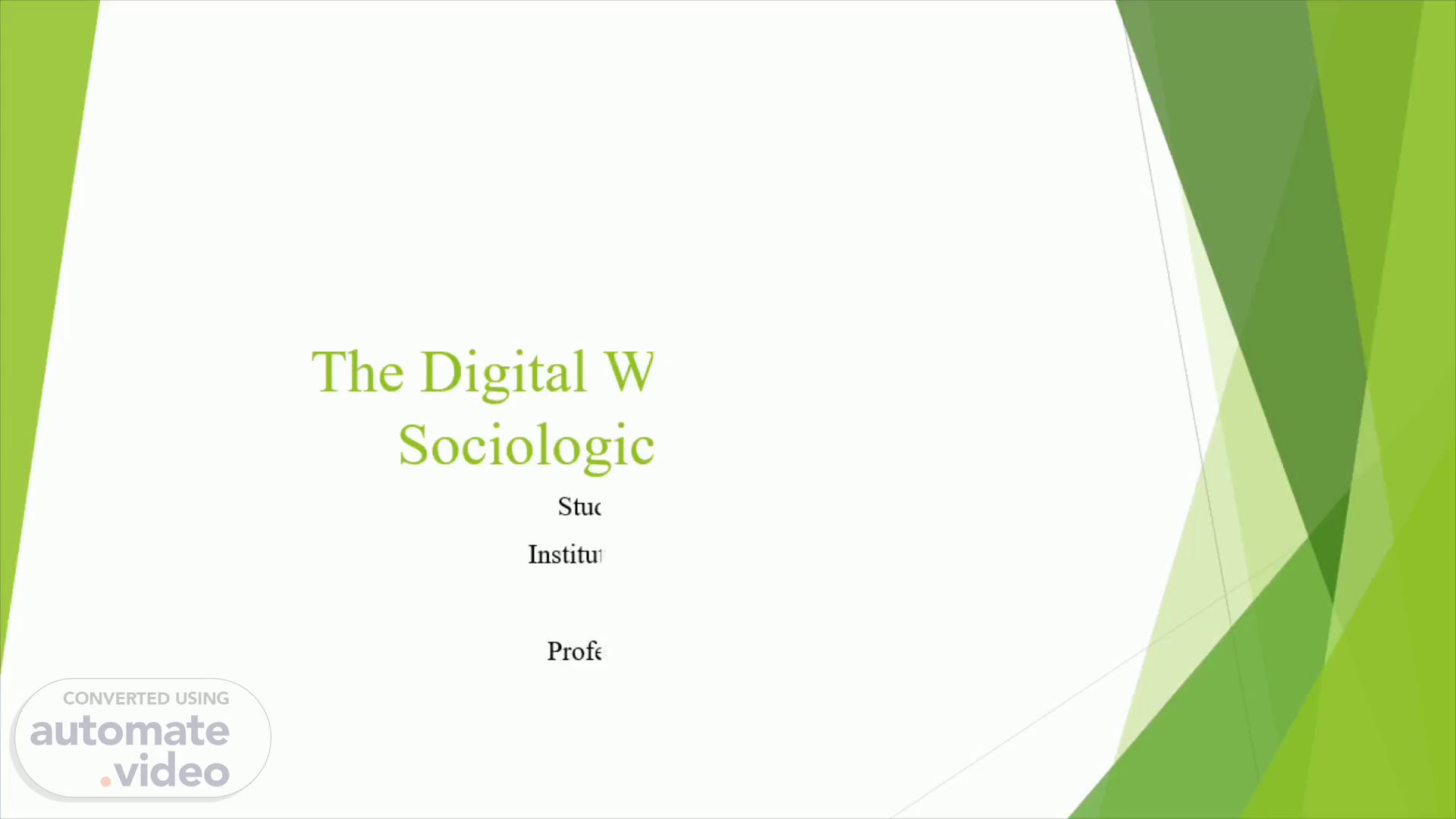
The Digital World Through Sociological Theory
Scene 1 (0s)
The Digital World Through Sociological Theory. Student’s Name Institution Affiliation Course Professor’s Name Date.
Scene 2 (8s)
Sociological Theories. Conflict Theory. States that; “society is in a state of perpetual conflict because of competition for limited resources” (Gallo, 2013). Marxist Approach; In a capitalist society conflict exist between the capitalist class who own factors of production and the working class whose alienated labor is exploited by the capitalists class..
Scene 3 (36s)
Use of technology and development of the current digital world.
Scene 4 (1m 21s)
Ways in which society has changed and contributing factors.
Scene 5 (1m 51s)
Examples of Technological Growth. Electricity is the most powerful technological change and growth over the past decades due to its benefits especially in manufacturing. Automobiles continue to develop to be more efficient with the electrical and green-energy powered vehicles as a technology to look forward to. Smartphones have facilitated communication in different ways for example, online communication has been key to globalization. The internet is a technological growth that has facilitated the online activities that have changed education, financial industry and e-commerce. Computerization is the adaptation of systems facilitated by computer for example, AI and machine learning are the future for businesses especially in understanding customer behaviors..
Scene 6 (2m 20s)
Technologies that have changed at organizational and societal levels.
Scene 7 (2m 45s)
Digital Divide. Tackling the Issues: See how LEE members are ending the 'digital divide' | Leadership for Educational Equity.
Scene 8 (3m 11s)
Factors that cause digital divide. Economic factors- the lack of adequate financial resources to support the associated infrastructure e.g., 5G connection or digital devices like computers and smartphones can lead to the divide. Skills- digital skills involve the capabilities to effectively use various digital devices including computers, smartphones or tablets thus, lack of these skills will impede the handling and usage of digital services. Age- different age groups evidenced by the different generation’s interaction with technology can create a divide due to the differences in perspectives about digital services and devices including misinformation on the benefits of the digital world. Geographic factors- there are various places in America and around the world with limited accessibility to high-speed internet services. Culture- some people simply do not want to connect to the digital world for different reasons including their cultural beliefs (Reddick et al., 2020)..
Scene 9 (3m 48s)
Bridging the Digital Divide. Digital literacy-Involves the ability and skills to use IT and digital technology effectively to create and communicate different types of information. Incorporating digital literacy in the school curriculum and exposure to digital devices early in life can bridge the divide through improving skills and cultural issues. Reddick et al., (2020) explains that the government needs to step up reduce the digital gap through reducing or providing subsidies to technological items or following the lead of Bill and Melinda Gates Foundation that develops high-tech classrooms globally. Seeking technologies that are appropriate to specific needs for example, those with magnifying devices or screen readers for physically challenged individuals. Digital awareness can be used to address economic, geographic and even social factors that cause the digital divide especially in communicating the benefits of digitalization in the current society..
Scene 10 (4m 24s)
Digital Divide in the Store. The digital divide is evident in the store through: Lack of computer access at the store creates a barrier to the store to exploit different business opportunities e.g., e-commerce When employees are required to complete some business at home those without personal computers cannot complete their work creating a performance barrier. Having prospective employees apply from home means limited career opportunities to those who do not have access, skills and devices to apply from home..
Scene 11 (4m 47s)
Theoretical perspective of the store. According to the symbolic interaction theory people find meaning of various aspects of life including technology through their interaction with such aspects. In this case, the store will understand the importance of the use of technology when they interact with it for example, through e-commerce or efficient operations in the different departments. It further explains that people make sense of their society through communication and social interaction i.e., exchange of meaning through symbols and language thus, when the store uses technology to communicate its expectations it may attract the right talent. This ideology helps bridge the digital divide as it creates awareness of the benefits of increased use of technology for business, communication and interacting with the locals. The theory can be used as a basis of promoting digital skills through having digital competency associated with higher career opportunities especially in the present generation..
Scene 12 (5m 25s)
References. Gallo, G. (2013). Conflict theory, complexity and systems approach. Systems Research and Behavioral Science , 30 (2), 156-175. https://nexacenter.org/nexacenterfiles/gallo2013conflict.pdf Reddick, C. G., Enriquez, R., Harris, R. J., & Sharma, B. (2020). Determinants of broadband access and affordability: An analysis of a community survey on the digital divide. Cities , 106 , 102904. https://www.sciencedirect.com/science/article/pii/S026427512031252X Tolentino, (2019). The Age of Instagram Face. The New Yorker https://www.newyorker.com/culture/decade-in-review/the-age-of-instagram-face Turner, J. H. (2011). Extending the symbolic interactionist theory of interaction processes: A conceptual outline. Symbolic Interaction , 34 (3), 330-339. https://www.researchgate.net/profile/Jonathan-Turner/publication/264488320_Extending_the_Symbolic_Interactionist_Theory_of_Interaction_Processes_A_Conceptual_Outline/links/5ed3231e299bf1c67d2cb60f/Extending-the-Symbolic-Interactionist-Theory-of-Interaction-Processes-A-Conceptual-Outline.pdf.